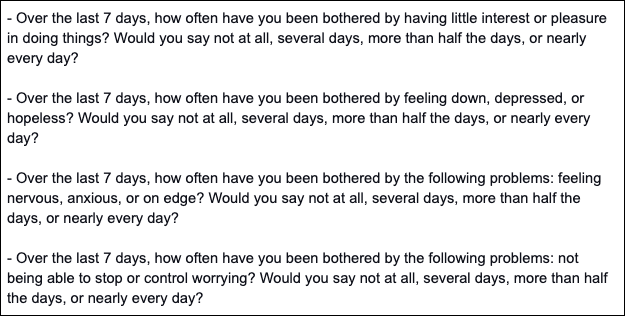Over 33% Americans showing signs of anxiety and depression amid pandemic lockdown, says survey

More than 33% or a third of Americans are showing clinical signs of anxiety disorder or depressive disorder, according to the US Census Bureau, which conducted a survey to understand the social and economic impact of the Covid-19 pandemic. The most recent data, based on information collated between May 14 to May 19, shows that 28.2% had symptoms of anxiety disorder, 24.4% had symptoms of depressive disorder, and 33.9% had symptoms of anxiety disorder or depressive disorder.
Between May 7-12, 34.4% of Americans were showing symptoms of anxiety disorder or depressive disorder, while the figure was 35.9% between April 23 and May 5. The analysis shows just how widespread the impact of the pandemic has been and the massive toll it has had on the mental health of people.


To rapidly monitor recent changes in mental health, the National Center for Health Statistics (NCHS) partnered with the Census Bureau on an experimental data system called the Household Pulse Survey. It is a 20-minute online survey studying how the coronavirus pandemic is impacting households across the country. The households were asked questions typically used to screen for mental health problems.
The questions are a modified version of the two-item Patient Health Questionnaire (PHQ-2) and the two-item Generalized Anxiety Disorder (GAD-2) scale on the Household Pulse Survey, collecting information on symptoms over the last 7 days (rather than the typical 14 days).
"This survey was designed to complement the ability of the federal statistical system to rapidly respond and provide relevant information about the impact of the coronavirus pandemic in the US. Estimates show the percentage of adults who report symptoms of anxiety or depression that have been shown to be associated with diagnoses of generalized anxiety disorder or major depressive disorder. These symptoms generally occur more than half the days or nearly every day," says the US Centers for Disease Control and Prevention (CDC).

Approximately 1,867,000 housing units were selected from the sampling frame for the first week of interviewing. About 75,000 respondents answered the online questionnaire. For the last third survey, ending May 19, the sample size was 1,287,000 and 133,000 responded.

The Census Bureau data reveal that some groups have been hit harder than others. Rates of anxiety and depression were far higher among younger adults, women, and those who had less than a high school diploma. According to the estimates for May 14-19, 47.7% in the 18-29 years age group were showing symptoms of anxiety disorder or depressive disorder, followed by 37.8% in the 30-39 age group, and 35.3% among those aged 40-49 years.
As compared to men (29.9%), women (37.6%) were more likely to display signs of anxiety disorder or depressive disorder. Such symptoms were also much more prevalent among those who did not have a high school diploma (40.9%), followed by those who had a high school diploma (37.6%).
Among the states, the largest percentage of people showing anxiety disorder or depressive disorder was in Mississippi (44.3%), followed by New Jersey (39.3%), California (38.8%), New Mexico (37.4), District of Columbia and Indiana (37.3% each). All percentages are for the week ending May 19. In New York, which had the worst coronavirus outbreak in the US, 34.9% were showing these symptoms.

The results also highlight a massive decline in the mental health of Americans when compared to data compiled in 2014. In a 2014 national survey, the Census Bureau found that 25% in the US experienced "depressive mood,” while the number is 50% during the coronavirus pandemic, shows analysis.
When the novel coronavirus emerged in the US, the priority was making sure that hospitals would not be overwhelmed and that as many lives as possible could be saved. After stay-at-home measures were announced in March in the US, businesses, restaurants and schools closed, remote work became the norm, and getting together with family and friends was no longer possible. Subsequently, many also lost their jobs. All this created a perfect storm for a mental health crisis, say experts.
Results from another report, which surveyed 2,032 US adults using a standard measure of mental distress on April 27, also reveal the devastating effect of Covid-19 on mental health. The study compared the responses with a sample of 19,330 demographically similar people in a 2018 government-sponsored survey of US adults that asked the same questions.
According to the analysis, the 2020 participants were eight times as likely to screen positive for serious mental illness – 27.7%, compared to 3.4% in the 2018 survey. The vast majority of the 2020 participants, 70.4%, met the criteria for moderate to serious mental illness, compared with 22% in 2018.
"Differences between the 2018 and 2020 samples appeared across all demographic groups, with larger differences among younger adults and those with children in the household. These considerable levels of mental distress may portend substantial increases in diagnosed mental disorders and in the morbidity and mortality associated with them," concludes the research team from San Diego State University and Florida State University.